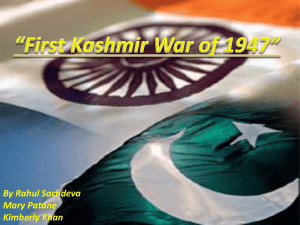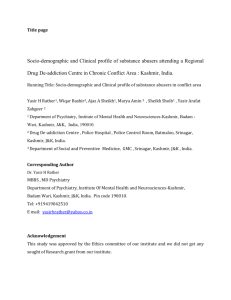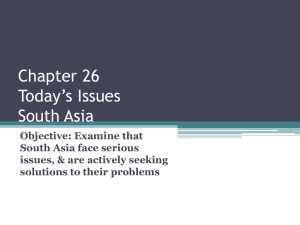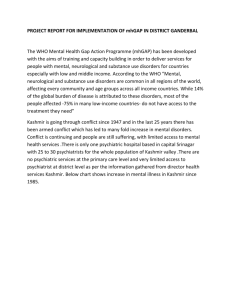Testing an Innovative, Low-Cost Model for Improving
advertisement
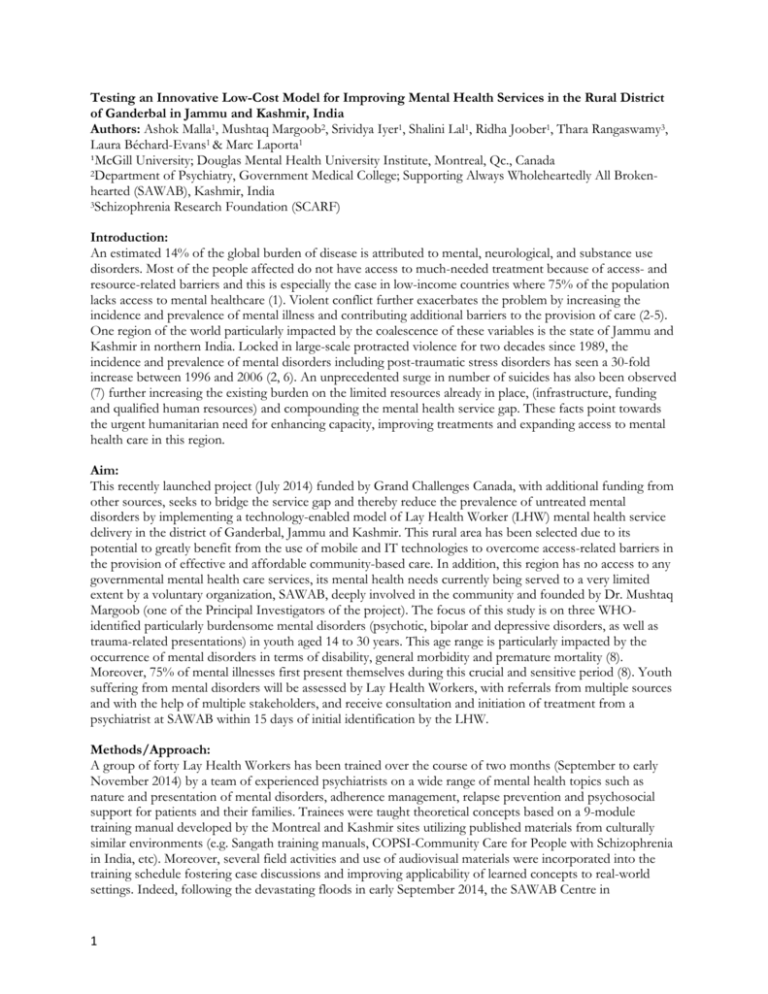
Testing an Innovative Low-Cost Model for Improving Mental Health Services in the Rural District of Ganderbal in Jammu and Kashmir, India Authors: Ashok Malla1, Mushtaq Margoob2, Srividya Iyer1, Shalini Lal1, Ridha Joober1, Thara Rangaswamy3, Laura Béchard-Evans1 & Marc Laporta1 ¹McGill University; Douglas Mental Health University Institute, Montreal, Qc., Canada 2Department of Psychiatry, Government Medical College; Supporting Always Wholeheartedly All Brokenhearted (SAWAB), Kashmir, India 3Schizophrenia Research Foundation (SCARF) Introduction: An estimated 14% of the global burden of disease is attributed to mental, neurological, and substance use disorders. Most of the people affected do not have access to much-needed treatment because of access- and resource-related barriers and this is especially the case in low-income countries where 75% of the population lacks access to mental healthcare (1). Violent conflict further exacerbates the problem by increasing the incidence and prevalence of mental illness and contributing additional barriers to the provision of care (2-5). One region of the world particularly impacted by the coalescence of these variables is the state of Jammu and Kashmir in northern India. Locked in large-scale protracted violence for two decades since 1989, the incidence and prevalence of mental disorders including post-traumatic stress disorders has seen a 30-fold increase between 1996 and 2006 (2, 6). An unprecedented surge in number of suicides has also been observed (7) further increasing the existing burden on the limited resources already in place, (infrastructure, funding and qualified human resources) and compounding the mental health service gap. These facts point towards the urgent humanitarian need for enhancing capacity, improving treatments and expanding access to mental health care in this region. Aim: This recently launched project (July 2014) funded by Grand Challenges Canada, with additional funding from other sources, seeks to bridge the service gap and thereby reduce the prevalence of untreated mental disorders by implementing a technology-enabled model of Lay Health Worker (LHW) mental health service delivery in the district of Ganderbal, Jammu and Kashmir. This rural area has been selected due to its potential to greatly benefit from the use of mobile and IT technologies to overcome access-related barriers in the provision of effective and affordable community-based care. In addition, this region has no access to any governmental mental health care services, its mental health needs currently being served to a very limited extent by a voluntary organization, SAWAB, deeply involved in the community and founded by Dr. Mushtaq Margoob (one of the Principal Investigators of the project). The focus of this study is on three WHOidentified particularly burdensome mental disorders (psychotic, bipolar and depressive disorders, as well as trauma-related presentations) in youth aged 14 to 30 years. This age range is particularly impacted by the occurrence of mental disorders in terms of disability, general morbidity and premature mortality (8). Moreover, 75% of mental illnesses first present themselves during this crucial and sensitive period (8). Youth suffering from mental disorders will be assessed by Lay Health Workers, with referrals from multiple sources and with the help of multiple stakeholders, and receive consultation and initiation of treatment from a psychiatrist at SAWAB within 15 days of initial identification by the LHW. Methods/Approach: A group of forty Lay Health Workers has been trained over the course of two months (September to early November 2014) by a team of experienced psychiatrists on a wide range of mental health topics such as nature and presentation of mental disorders, adherence management, relapse prevention and psychosocial support for patients and their families. Trainees were taught theoretical concepts based on a 9-module training manual developed by the Montreal and Kashmir sites utilizing published materials from culturally similar environments (e.g. Sangath training manuals, COPSI-Community Care for People with Schizophrenia in India, etc). Moreover, several field activities and use of audiovisual materials were incorporated into the training schedule fostering case discussions and improving applicability of learned concepts to real-world settings. Indeed, following the devastating floods in early September 2014, the SAWAB Centre in 1 collaboration with the Institute of Mental Health and Neurosciences, Kashmir, organized an outreach community psychosocial care camp in the Boat Colony Bemina (Srinagar) where the Lay Health Worker group worked closely with 400 attending patients under the supervision of mental health professionals. Ongoing support and supervision will continue to be provided in face-to-face meetings, field visits and webbased video conferencing by SAWAB mental health professionals and specialists. In this project, the provision of cost-effective, appropriate and accessible mental health service delivery by Lay Health Workers with focused but minimal training is entirely enabled by the use of mobile and IT technologies. Lay Health Workers will use cellphones (phone calls and text messaging) to communicate on a weekly basis with patients thereby cultivating engagement, providing psycho-education and facilitating relapse and suicide prevention. Netbooks will be used by Lay Health Workers to request online supervision, access training materials as well as videos and complete questionnaires regarding their experiences as well as patients’ symptom progression and daily functioning. Collected outcome and care data will be uploaded to a cloudbased database once Wi-Fi connection is made available improving quality assurance and monitoring the overall timeliness of data collection. To overcome challenges imposed by the remoteness and mountainous geography of the catchment area, tele-psychiatry will be leveraged for the provision of psychiatric consultations. Planning for mobile tele-psychiatry, initiated in collaboration with SCARF (Schizophrenia Research Foundation, India), will take place in the next phase of the project. Finally, mass media will be commissioned to increase awareness of mental health issues and to advertise the availability of services offered by SAWAB. Several articles have already been published in local newspapers to address the alarming increase in number of suicides, drug abuse/addiction, gambling and major psychiatric disorders and to stress the importance of help-seeking behaviours in times of need. Mental health awareness campaigns in the region have been launched and documented in the media thereby cultivating social mobilization around this troublesome topic and hopefully, improving referrals of affected individuals to appropriate services. Along with non-specialist provision of mental health care and use of information technology as well as media-related activities, stakeholder engagement is fostered to generate broader mental illness awareness, improve case identification and reduce stigma. This project enlists support from a diversified group of stakeholders in the community such as local imams and faith healers (both of whom are highly socially esteemed) (9) and are known to be the first points of contact for over 80% of SAWAB’s patients), school teachers, community elders, local self-government leaders, community health care personnel, and prior mental healthcare recipients (who have been the source of over 70% of the referrals to SAWAB). In addition to helping refine the service model and referring patients, these stakeholders help promote mental health literacy, general acceptance, and engagement. On August 24th 2014, the project was launched at the Town Hall in Ganderbal and was attended by the District Development Commissioner of Ganderbal, senior army and police officers as well as senior citizens of the district. This crucial event represents a first step towards ensuring widespread dissemination of the availability of mental health services at SAWAB, generating awareness and improving identification of mental health problems in youth. Results: At present, measurable impacts have yet to be documented as the project was officially launched in July 2014 following the reception of the ethics approval from the Indian Council of Medical Research (ICMR) and International Health division in late June 2014. Tragically, in early September 2014, severe floods hit the Kashmir valley devastating basic infrastructures, killing hundreds of people and leaving thousands homeless. Despite the wide spread destruction, training of Lay Health Workers took place and was finalized in early November 2014. Once patients are identified as suffering from major mental disorders and referred to appropriate psychiatric care, qualitative and quantitative outcome measurements will be initiated. With regards to training and supervision of Lay Health Workers, knowledge retention, correct identification of cases and number of contacts made with supervisors will be documented. Pathways to care, time from onset of illness to referral and number of contacts between patients and Lay Health Workers will be recorded throughout the project ensuring that the team delivers timely and appropriate care. Patient and family member outcomes will be of utmost importance and documented using three published symptom and 2 functioning scales as well as questionnaires assessing satisfaction and perception of services. Finally, the benefits of using technology will be assessed by documenting the perceptions of Lay Health Workers via a short questionnaire. Number of contacts between patients and health workers using cell phones as well as percent of online requests for supervision will also be recorded. Conclusion: Once completed, this pilot study will have demonstrated the feasibility and utility of a low-cost, skills-transfer based, technology-enhanced service delivery model. It will reveal that this approach can result in a reduction in the prevalence of untreated mental disorders and lay the groundwork for scaling this model up in the future to meet the needs of other parts of the state of Jammu and Kashmir and cover a larger range of mental health problems. In scaling up, we hope to also address the mental health needs of refugees from Kashmir who have been displaced from their millennia-old ancestral lands and live in miserable conditions in refugee camps outside the Valley. References: 1. http://www.who.int/mental_health/mhgap/en/ 2. Margoob M. A, Firdosi, M. M., & Banal R. (2006). Community prevalence of trauma in South AsiaExperience from Kashmir. JK-Practitioner, Supplement 1, 13, S14. 3. Margoob, M. A., & Ahmad, S. A. (2006).Community prevalence of adult post-traumatic stress disorder in South Asia-Experience from Kashmir. JK-Practitioner, Spl 1, 13, S18. 4. Margoob, M. A. (2006). Post disaster recovery: Issues, impressions and interventions. JKPractitioner, Spl Supplement 1, 13, S10. 5. Khan, A. Y., & Margoob, M. A. (2006). Pediatric PTSD: Clinical presentation, traumatic events and socio-demographic variables—Experience from a chronic conflict zone. JK- Practitioner, Spl. 1, 13, S40. 6. Margoob, M. A., & Ahmad, S. A. (2006).Community prevalence of adult post-traumatic stress disorder in South Asia-Experience from Kashmir. JK-Practitioner, Spl 1, 13, S18. 7. Margoob, M.A., Aslam, M & Singh A. A study of suicide attempters in Kashmir valley over the past six months (April-Sept 1997) experiences from psychiatric outpatients population. Paper presented in the Annual Indian psychiatric society meeting 1997. 8. Jones, P. B. (2013). Adult mental health disorders and age of onset. British Journal of Psychiatry, 202,s5s10. 9. Mushtaq, H., & Margoob, M. A. (2006). Pir, Faqir and Psychotherapist: Their role in psychosocial intervention of Trauma. JK-Practitioner, Spl Supplement 1, 13, S89. 3

